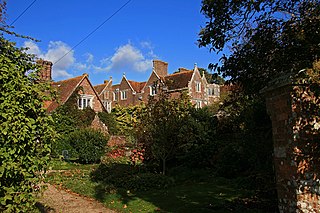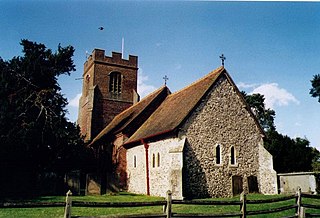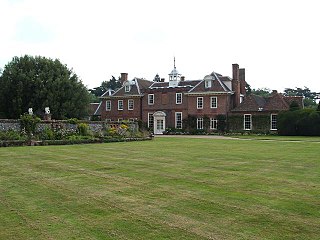
Topiary is the horticultural practice of training perennial plants by clipping the foliage and twigs of trees, shrubs and subshrubs to develop and maintain clearly defined shapes, whether geometric or fanciful. The term also refers to plants which have been shaped in this way. As an art form it is a type of living sculpture. The word derives from the Latin word for an ornamental landscape gardener, topiarius, a creator of topia or "places", a Greek word that Romans also applied to fictive indoor landscapes executed in fresco.

Eythrope is a hamlet and country house in the parish of Waddesdon, in Buckinghamshire, England. It is located to the south east of the main village of Waddesdon. It was bought in the 1870s by a branch of the Rothschild family, and belongs to them to this day.

Edmondsham is a village in the county of Dorset in southern England. It is situated two miles north west of Verwood and ten miles north of Bournemouth. It is sited near the source of a small stream River Ed which flows into the River Crane, Dorset; both are Sites of Special Scientific Interest. In the 2001 Census it had a population of 200. The surrounding countryside is well-wooded. Edmondsham House was built in 1589 as marked on centre gable stone pillar, builders William Arnold and family - who later 1607-10 or 1609-13 finished off Cranborne Manor House, all three Arnolds having concentrated on Monteacute House 1590 - 1601; and in 1905 was described by Sir Frederick Treves as "grey with age" - in fact it is grey from the use of Marl "roman" Cement locally sourced from the glauconitic seam through the estate, and hence "like a mist in the wood".

Anderson, sometimes known as Winterborne Anderson, is a small village and civil parish in Dorset, England, situated in the North Dorset administrative district about 9 miles (14 km) northwest of Poole. To the west are Winterborne Muston and Winterborne Kingston and to the east are Winterborne Tomson and Winterborne Zelston. In 2013 the estimated population of the parish was 60.

Ruscombe is a village and civil parish, east of Twyford in the Borough of Wokingham in Berkshire, England.

Trevalyn Hall in Rossett, a Grade II* listed building, is an Elizabethan manor house near Wrexham in Wales. It was built by John Trevor in 1576. The Trevor family of Trevalyn were one of the leading families in East Denbighshire by about 1600 with numerous estates in both Flintshire and Denbighshire. The Plas Teg estate in Hope, Flintshire was also acquired by the Denbighshire branch of the family when it was purchased from a cousin by Sir John Trevor I (1563–1630) and it was he who built the present Plas Teg house in 1610.

Sharsted Court is a grade I listed manor house set in woodland near the village of Newnham, Kent England. A house or lodge has been recorded at the site since the time of Odo de Bayeux in 1080, however the present building, exhibiting a number of later styles, principally dates from the 18th century. Earlier residents of the site may have included Iron Age settlers since excavations of earthworks on the estate in 1825 and 1880 revealed evidence of possible Belgic fortifications.

Crewe Hall is a Jacobean mansion located near Crewe Green, east of Crewe, in Cheshire, England. Described by Nikolaus Pevsner as one of the two finest Jacobean houses in Cheshire, it is listed at grade I. Built in 1615–36 for Sir Randolph Crewe, it was one of the county's largest houses in the 17th century, and was said to have "brought London into Cheshire".

Burton Manor is a former manor house in the village of Burton, Cheshire, England. It is recorded in the National Heritage List for England as a designated Grade II listed building. At one time an adult education college, this is now closed, but the walled garden is open to the public and is administered by the Friends of Burton Manor Gardens.

Nailsea Court in Nailsea, Somerset, England, is an English manor house dating from the 15th century. Pevsner describes the house as "historically highly instructive and interesting" and it is a Grade I listed building.

Becconsall Old Church is a redundant church in the village of Hesketh Bank, Lancashire, England. It is recorded in the National Heritage List for England as a designated Grade II listed building, and is in the care of the Churches Conservation Trust. It is situated on a lane leading to a boatyard on the River Douglas.

Lower Huxley Hall is a moated manor house in Cheshire, England, located about 6.5 miles (10 km) southeast of Chester. It lies roughly halfway between the villages of Huxley and Hargrave, It dates from the late 15th century, with major additions and alterations in the 17th century. A small addition was made to the rear in the 19th century. It was originally a courtyard house, but only two wings remain. The house is designated by English Heritage as a Grade II* listed building.

Shotwick Hall is a former manor house in the village of Shotwick, Cheshire, England. It replaced an earlier manor house that stood on a moated site some 150 metres to the west. The hall and four associated structures are listed buildings, and the moated site is a Scheduled Monument.

Winterborne Clenston is a small village and civil parish in Dorset, England, around 3+1⁄2 miles southwest of Blandford Forum. In 2013 the civil parish had an estimated population of 40.

Winterborne Tomson is a village and former civil parish, now in the parish of Anderson, in the Dorset, district, in the ceremonial county of Dorset, England. In 1931 the parish had a population of 35. On 1 April 1933 the parish was abolished and merged with Anderson.

Mount Ephraim Gardens is an Edwardian terraced gardens located at Hernhill, near Faversham, in the English county of Kent.
Bloxworth House is a Grade I listed manor house just northwest of the village of Bloxworth in Dorset, England. It was built in 1608 by George Savage and was the first brick building in Dorset.

Ince Blundell Hall is a former country house near the village of Ince Blundell, in the Metropolitan Borough of Sefton, Merseyside, England. It was built between 1720 and 1750 for Robert Blundell, the lord of the manor, and was designed by Henry Sephton, a local mason-architect. Robert's son, Henry, was a collector of paintings and antiquities, and he built impressive structures in the grounds of the hall in which to house them. In the 19th century the estate passed to the Weld family. Thomas Weld Blundell modernised and expanded the house, and built an adjoining chapel. In the 1960s the house and estate were sold again, and have since been run as a nursing home by the Canonesses of St. Augustine of the Mercy of Jesus.

Todenham is a village and civil parish in the Cotswold district of Gloucestershire, England. The village is significant for its Grade I listed 14th-century parish church.

Plaish Hall is a country house in Plaish, in the civil parish of Cardington, in the Shropshire district, in the ceremonial county of Shropshire, England. It is recorded in the National Heritage List for England as a designated Grade I listed building.



















